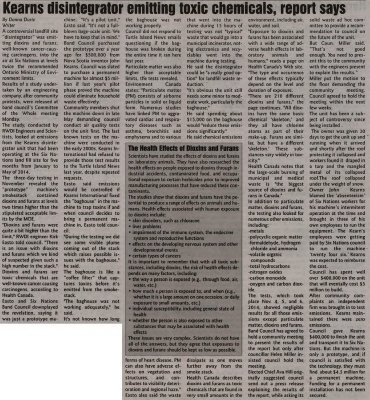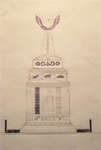"Kearns disintegrator emitting toxic chemicals, report says"
- Publication
- Turtle Island News, 21 Jan 2015
- Full Text
- Kearns disintegrator emitting toxic chemicals, report saysBy Donna Duric, Writer
A controversial landfill site "disintegrator" was emitting dioxins and furans, well-known cancer-causing carcinogens, into the air at Six Nations at levels twice the recommended Ontario Ministry of Environment limits.
Results of a study undertaken by an engineering company, after community protests, were released at band council's Committee of the Whole meeting Monday.
The study, conducted by RWDI Engineers and Scientists, looked at emissions from the Kearns disintegrator unit that had been operating at the Six Nations land fill site for five months from January to May of 2014.
The three-day testing in November revealed the "prototype" machine's smokestack contained dioxins and furans at levels two times higher than the stipulated acceptable limits by the MOE.
"Dioxins and furans were quite a bit higher than the limit," RWDI engineer Kirk Easto told council. "There is an issue with dioxins and furans which we kind of suspected given such a high number in the stack."
Dioxins and furans are toxic chemicals that are toxic chemicals that are well-known cancer causing carcinogens, according to Health Canada.
Easto and Six Nations Band Council downplayed the revelation, saying it was just a prototype machine. "It's a pilot unit," Easto said. "It's not a full-blown large-scale unit. We have to keep that in mind."
Band Council purchased the prototype over a year ago for $500,000 from Nova Scotia inventor John Kearns. Council was slated to purchase a permanent machine for almost $5 million if last year's pilot phase proved the machine could eliminate household waste effectively.
Community members shut the machine down in late May demanding council conduct air quality tests on the unit first. The last known tests on the machine were conducted in the early 2000s. Kearns International had refused to provide those test results to the Turtle Island News last year, despite repeated requests.
Easto said emissions would be controlled if Kearns International fixed the "baghouse" in the machine to trap toxins if and when council decides to bring a permanent machine in, Easto told council.
"During the testing we did see some visible plume coming out of the stack which raises possible issues with the baghouse," he said.
The baghouse is like a "coffee filter" that captures toxins before it's emitted from the smokestack.
"The baghouse was not working adequately," he said.
It's not known how long the baghouse was not working properly.
Council did not not respond to Turtle Island News emails questioning if the baghouse was broken during the entire time it ran here last year.
Particulate matter was also higher than acceptable limits, the tests revealed.
Environment Canada states: "Particulate matter (PM) consists of airborne particles in solid or liquid form. Numerous studies have linked PM to aggravated cardiac and respiratory diseases such as asthma, bronchitis and emphysema and to various forms of heart disease. PM can also have adverse effects on vegetation and structures, and contributes to visibility deterioration and regional haze."
Easto also said the waste that went into the machine during 15 hours of testing was not "typical" waste that would go into a municipal incinerator, noting electronics and recyclables went into the machine during testing.
He said the disintegrator could be "a really good option" for landfill waste reduction.
"It's obvious the unit still needs some minor to moderate work, particularly the baghouse."
He said spending about $15,000 on the baghouse would "reduce these emissions significantly."
He said chemical emissions dissipate as one moves further away from the smoke stack.
Health Canada describes dioxins and furans as toxic chemicals that are found in very small amounts in the environment, including air, water, and soil.
"Exposure to dioxins and furans has been associated with a wide range of adverse health effects in laboratory animals and humans," reads a page on Health Canada's Wed site.
"The type and occurrence of these effects typically depend on the level and duration of exposure.
"There are 210 different dioxins and furans," the page continues. "All dioxins have the same basic chemical 'skeleton,' and they all have chlorine atoms as part of their make-up. Furans are similar, but have a different 'skeleton.' These substances vary widely in toxicity."
Health Canada notes that the large-scale burning of municipal and medical waste is "the biggest source of dioxins and furans in Canada."
In addition to particulate matter, dioxins and furans, the testing also looked for numerous other emissions, including:
- metals
- polycyclic organic matter
- formaldehyde, hydrogen chloride and ammonia
- volatile organic compounds
- total hydrocarbons
- nitrogen oxides
- carbon monoxide
- oxygen and carbon dioxide
The tests, which took place Nov. 4, 5, and 6, 2014, showed negligible results for all those emissions except particulate matter, dioxins and furans.
Band Council has agreed to hold a community meeting to present the results of the report but only after councillor Helen Miller insisted council hold the meeting.
Elected Chief Ava Hill originally suggested council send out a press release explaining the results of the report, while asking its solid waste ad hoc committee to provide a recommendation to council on the future of the unit.
But Coun. Miller said, "That's not good enough. You need to present this to the community with the engineers present to explain the results."
Miller put the motion to the floor demanding the community meeting. Council agreed to hold the meeting within the next few weeks.
The unit has been a subject of controversy since being installed.
The owner was given 30 days to get the unit up and running when it arrived and shortly after the roof protecting it collapsed and workers found it draped in a tarp and the mangled metal of its collapsed roof. The roof collapsed under the weight of snow.
Owner John Kearns blamed the 'absenteeism' of Six Nations workers for his machine's intermittent operation at the time and brought in three of his own employees to run the equipment. The Kearns employees were getting paid by Six Nations council to run the machine 'twenty four six.' Kearns was expected to reimburse the cost.
Council has spent well over $400,000 on the unit that will eventually cost $5 million to build.
After community complaints an independent firm was brought in to test emissions. Kearns maintained there were zero emissions.
Council gave Kearns $400,000 to finish the unit and transport it to Six Nations. But the machine is only a prototype, and if council is satisfied with the technology, they must find about $4.5 million for a permanent machine.
Funding for a permanent installation has not been secured.
- Creator
- Duric, Donna, Author
- Media Type
- Text
- Newspaper
- Item Type
- Clippings
- Publisher
- Turtle Island News
- Place of Publication
- Six Nations of the Grand River, ON
- Date of Publication
- 21 Jan 2015
- Date Of Event
- 18 Jan 2015
- Subject(s)
- Personal Name(s)
- Easto, Kirk ; Kearns, John ; Miller, Helen ; Hill, Chief Ava.
- Corporate Name(s)
- Kearns International ; Six Nations Elected Band Council ; Ontario Ministry of Environment ; RWDI Engineers and Scientists ; Environment Canada ; Health Canada.
- Local identifier
- SNPL004672v00d
- Language of Item
- English
- Geographic Coverage
-
-
Ontario, Canada
Latitude: 43.06681 Longitude: -80.11635
-
- Creative Commons licence
 [more details]
[more details]- Copyright Statement
- Public domain: Copyright has expired according to Canadian law. No restrictions on use.
- Copyright Date
- 2015
- Copyright Holder
- Turtle Island News
- Contact
- Six Nations Public LibraryEmail:info@snpl.ca
Website:
Agency street/mail address:1679 Chiefswood Rd
PO Box 149
Ohsweken, ON N0A 1M0
519-445-2954



